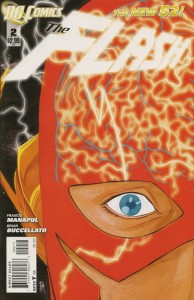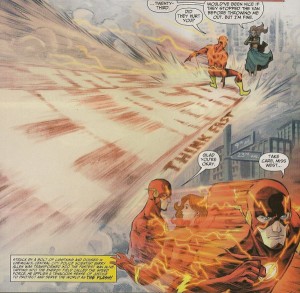 EDITOR’S NOTE: This review may contain spoilers. Or it may just contain my suspicion that “The Speed Force” comes in powdered form. You are warned.
EDITOR’S NOTE: This review may contain spoilers. Or it may just contain my suspicion that “The Speed Force” comes in powdered form. You are warned.
Here’s the first problem I have with Francis Manapul’s and Brian Buccellato’s New 52 reboot of The Flash: it’s not Mike Baron’s and Jackson Guice’s 1987 post-Crisis reboot of The Flash. To me, that book is the definitive reboot.
It put a new guy in the costume. It completely rethought how the powerset worked – to my knowledge, Mike Baron was the first person to make the mental leap that moving at that speed would require a lot of food and sleep to maintain… something he probably extrapolated from his prodigious use of cocaine. In short: it changed everything, and in doing so, it made it fascinating.
So when I read Manapul’s and Buccellato’s Flash, I kept wishing that I was actually reading Baron’s for the first time… and not just because it would mean that I was 17 years old and 175 pounds again. But also because this book, while beautiful, is completely uneven.
Let’s start with the best part about the new Flash: the art. Manapul’s art in this book is fucking beautiful. Manapul’s speed effects are spectacular, the foreground pencils are sharp and faces expressive, while the backgrounds are somewhat abstracted, giving the effect of The Flash moving decisively through a hazy world that’s standing still.
Buccellato’s colors support the effect; Flash and what he’s focusing on are sharp, standard comics coloring while the backgrounds look almost watercolored. The overall effect gives visual character to how you might perceive the world living as The Flash, or on prodigious amounts of cocaine.
And since Manapul and Buccellato are also writing the book, they give themselves room to build nifty little visual effects into the storytelling itself. I mean, look at this title panel:
That’s some cool art right there. Based on that, I’d be happy to pony up some dough in SDCC’s Artists’ Alley for these guys to do a Flash commission. I’m just not sure I’d pay them to write The Flash.
The story this art is supporting is… not all there. By which I partially mean that I read the damn book through three times, and I’m not sure I can follow just what the hell is going on here.
One of the things we start out with in this book is Flash being examined by a scientist who tells Flash that he needs to learn how to think as fast as he runs. Literally six panels later, while looking at a pretty blonde with nice jugs, he can suddenly do just that. With no explanation whatsoever. How’d it happen? Was it the blonde? The tits? Because either often make my thoughts go faster: “Tell her you’re rich – no, that you’re famous! But how can you say you’re famous when she doesn’t know who you are? Secret agent, maybe? No, a secret agent wouldn’t have a spontaneous erection and be slightly drooling, you moron!” Which seems to be an unlikely form of “quick” thinking to help in superheroics. Maybe there is no explanation. Or maybe he just did prodigious amounts of cocaine.
The story proper revolves around The Flash searching for an old college buddy who’s gone missing and might have been cloned. So while Flash hunts down clues, we get a bunch of backstory in flashback, with only some of it being utterly and disturbingly homoerotic (Story page 15. you’ll know it when you see it and feel vaguely icky).
But the problem is that the visual cue that we’re in flashback is a bluish tinge to the art. But there is a present-day sequence dealing with some of the same characters that’s tinted purple. So if you miss the subtle cues as to when what you’re seeing is happening, it’s vastly too easy to lose track of where the fuck you are in the story. And because of that, there was a point toward the climax where I was convinced I was seeing an event that occurred years ago… that was causing an apocalyptic event today. And while it’s possible that it’s my fault as a reader, let’s keep in mind I have a college education, 35 years experience reading comics, and that for a change I read Flash sober when I say that I shouldn’t need to reread a sequence several times in order to understand what panel is happening in what year.
And even when I did understand, it still didn’t make a lot of sense. I’m no biologist, but I understand what cloning is… so why is it causing an electromagnetic pulse? In the air? And why, exactly, am I even bothering to read about The Fastest Man Alive hunting for who seems to be his college experimental asshole buddy at a fucking pig farm (Not to be confused with a pig fucking farm… I think. I am that confused about what’s going on in this book)?
Look, let’s bottom line it: this is a beautiful book that is being written by people who are not writers. And while it’s not the disaster that Tom Morello’s Orchid is shaping up to be, the story has problems. So if you’re into comics based on the art, I wholeheartedly recommend this book.
If you were hoping for a good story about what it’s like to be speedy? Save your money. And spend instead it on prodigious amounts of cocaine.

 Podcast RSS Feed
Podcast RSS Feed iTunes
iTunes Google Play
Google Play Stitcher
Stitcher TuneIn Radio
TuneIn Radio Android
Android Miro Media Player
Miro Media Player Comics Podcast Network
Comics Podcast Network